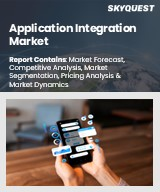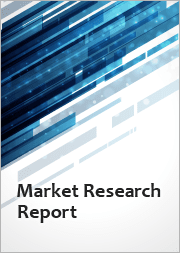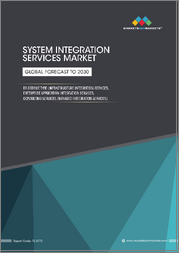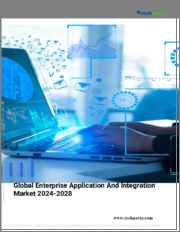
|
시장보고서
상품코드
1575486
세계의 기업 애플리케이션 통합 시장 : 솔루션 유형별, 전개 형태별, 기업 규모별, 업계별, 서비스 유형별, 최종 사용자별 예측(2025-2030년)Enterprise Application Integration Market by Solution Type, Deployment Mode, Enterprise Size, Industry Vertical, Service Type, End User - Global Forecast 2025-2030 |
||||||
기업 애플리케이션 통합 시장의 2023년 시장 규모는 138억 9,000만 달러, 2024년에는 154억 4,000만 달러에 이를 것으로 예상되며 CAGR 11.77%로 성장하여 2030년에는 302억 8,000만 달러 그렇다고 예측됩니다.
기업 애플리케이션 통합(EAI)은 서로 다른 소프트웨어 용도과 IT 시스템 간의 원활한 연결성을 의미하며 조직 전체의 데이터 공유 및 프로세스 자동화를 가능하게 합니다. EAI의 범위에는 미들웨어 솔루션, 비즈니스 프로세스 통합을 위한 도구, 서비스 지향 아키텍처(SOA) 등의 기술이 포함됩니다. EAI의 필요성은 업무를 간소화하고, 사일로화를 줄이고, 실시간 정보 흐름을 가능하게 할 필요성 때문입니다. EAI는 금융, 헬스케어, 소매업, 제조업 등 다양한 분야에서 응용되고 있으며, 이종 시스템 간의 데이터에 통일적인 액세스를 제공함으로써 워크플로우 최적화 및 의사결정 개선에 도움이 됩니다. ERP, CRM, SCM 시스템 등의 통합이 필요한 모든 기업을 포함하여 최종 용도의 범위는 광범위합니다.
| 주요 시장 통계 | |
|---|---|
| 기준년(2023) | 138억 9,000만 달러 |
| 예측년(2024) | 154억 4,000만 달러 |
| 예측년(2030) | 302억 8,000만 달러 |
| CAGR(%) | 11.77% |
시장 성장의 주요 요인은 클라우드 기반 솔루션에 대한 수요가 증가하고, 비즈니스 민첩성에 대한 요구가 증가하고, 업계 전반에 걸쳐 진행되는 디지털 변환입니다. 인공지능(AI)과 머신러닝을 EAI 솔루션에 통합하고 예측 능력과 업무 효율성을 높이는 데는 큰 기회가 있습니다. 또한 IoT 디바이스와 엣지 컴퓨팅의 채용이 진행됨에 따라 EAI에 새로운 길이 열리고 연결성과 데이터 활용이 강화됩니다. 그러나 과제로는 통합 복잡성, 데이터 교환과 관련된 보안 문제, 배포 초기 비용 상승 등이 있습니다. 이러한 장애를 극복하려면 신중한 계획과 구현을 위한 민첩한 접근이 필요합니다.
EAI의 혁신적인 R&D 분야에서는 통합 환경에 맞는 사이버 보안 대책 개선, 통합 프로세스를 간소화하는 로우코드 또는 노코드 통합 플랫폼 개발, 안전한 데이터 공유를 위한 블록체인 기술 탐구 등이 있습니다. 시장은 급속한 기술 진보와 경쟁 압력을 특징으로 하며, 기업은 지속적인 기술 혁신과 보다 견고하면서도 사용자 친화적인 솔루션을 제공해야 합니다. EAI를 활용하려는 기업은 현대 기업의 역동적인 요구를 충족시키기 위해 확장성, 상호 운용성 및 실시간 데이터 처리 능력을 강조해야 합니다. EAI가 디지털 변환 전략에 점점 더 중요해지고 있는 가운데 이러한 통찰과 기회를 효과적으로 활용하는 조직은 큰 성장을 이룰 수 있습니다.
시장 역학: 빠르게 진화하는 기업 애플리케이션 통합 시장의 주요 시장 인사이트 공개
기업 애플리케이션 통합 시장은 수요 및 공급의 역동적인 상호작용으로 변모하고 있습니다. 이러한 시장 역학의 진화를 이해함으로써 기업은 충분한 정보를 바탕으로 투자결정, 전략적 결정 정밀화, 새로운 비즈니스 기회 획득에 대비할 수 있습니다. 이러한 동향을 종합적으로 파악함으로써 기업은 정치적, 지리적, 기술적, 사회적, 경제적 영역에 걸친 다양한 리스크를 경감할 수 있을 뿐만 아니라, 소비자 행동과 그것이 제조 비용 또는 구매 동향에 미치는 영향을보다 명확하게 이해할 수 있습니다.
- 시장 성장 촉진요인
- 통합이 필요한 대량의 데이터를 생성하는 IoT 디바이스의 급증
- 미들웨어 솔루션이 필요한 업계 전체의 디지털 전환 구상의 가속
- 효율적인 데이터 통합을 필요로 하는 빅 데이터 분석 툴의 채용 증가
- 합리적인 백엔드 시스템 통합이 필요한 전자상거래 플랫폼 확대
- 시장 성장 억제요인
- 기업 애플리케이션 통합 솔루션의 도입 및 유지보수 비용이 높다
- 시장 기회
- 기업의 클라우드 서비스와 온프레미스 용도의 원활한 통합에 대한 수요 증가
- 통합 용도을 통한 실시간 데이터 분석 및 비즈니스 인텔리전스에 대한 요구 증가
- 사물인터넷(IoT) 디바이스의 도입이 진행되고, 통합 기업 시스템의 요구가 높아지고 있는 것
- 시장의 과제
- 급속히 진화하는 기술 상황에 따라 기업은 새로운 소프트웨어, 플랫폼 및 표준에 통합 전략을 지속적으로 적응시키는 것이 어려워지고 있습니다.
Portre's Five Forces: 기업 애플리케이션 통합 시장을 탐색하는 전략 도구
Porter's Five Forces 프레임워크는 기업 애플리케이션 통합 시장 경쟁 구도를 이해하는 중요한 도구입니다. Porter's Five Force Framework는 기업의 경쟁력을 평가하고 전략적 기회를 탐구하는 명확한 기술을 제공합니다. 이 프레임워크는 기업이 시장 내 세력도를 평가하고 신규 사업의 수익성을 결정하는 데 도움이 됩니다. 이러한 통찰을 통해 기업은 자사의 강점을 활용하고, 약점을 해결하고, 잠재적인 과제를 피할 수 있으며, 보다 강인한 시장에서의 포지셔닝을 보장할 수 있습니다.
PESTLE 분석 : 기업 애플리케이션 통합 시장에서 외부 영향을 파악
외부 거시적 환경 요인은 기업 애플리케이션 통합 시장의 성과 역학을 형성하는데 매우 중요한 역할을 합니다. 정치적, 경제적, 사회적, 기술적, 법적, 환경적 요인 분석은 이러한 영향을 탐색하는 데 필요한 정보를 제공합니다. PESTLE 요인을 조사함으로써 기업은 잠재적인 위험과 기회를 더 잘 이해할 수 있습니다. 이 분석을 통해 기업은 규제, 소비자 선호, 경제 동향의 변화를 예측하고 앞으로 예상되는 적극적인 의사 결정을 할 준비를 할 수 있습니다.
시장 점유율 분석 : 기업 애플리케이션 통합 시장에서 경쟁 구도 파악
기업 애플리케이션 통합 시장의 상세한 시장 점유율 분석을 통해 공급업체의 성과를 종합적으로 평가할 수 있습니다. 기업은 수익, 고객 기반, 성장률 등 주요 지표를 비교하여 경쟁 포지셔닝을 밝힐 수 있습니다. 이 분석을 통해 시장 집중, 단편화, 통합 동향을 밝혀내고 공급업체는 경쟁이 치열해지면서 자사의 지위를 높이는 전략적 의사 결정을 내리는 데 필요한 지식을 얻을 수 있습니다.
FPNV 포지셔닝 매트릭스 : 기업 애플리케이션 통합 시장에서 공급업체의 성능 평가
FPNV 포지셔닝 매트릭스는 기업 애플리케이션 통합 시장에서 공급업체를 평가하는 중요한 도구입니다. 이 행렬을 통해 비즈니스 조직은 공급업체의 비즈니스 전략과 제품 만족도를 기준으로 평가하여 목표에 맞는 충분한 정보를 바탕으로 의사 결정을 내릴 수 있습니다. 네 가지 사분면을 통해 공급업체를 명확하고 정확하게 세분화하여 전략 목표에 가장 적합한 파트너 및 솔루션을 파악할 수 있습니다.
전략 분석 및 추천 : 기업 애플리케이션 통합 시장에서 성공을 위한 길을 그리기
기업 애플리케이션 통합 시장의 전략 분석은 세계 시장에서의 프레즌스 강화를 목표로 하는 기업에 필수적입니다. 주요 자원, 능력 및 성과 지표를 검토함으로써 기업은 성장 기회를 파악하고 개선을 위해 노력할 수 있습니다. 이러한 접근 방식을 통해 경쟁 구도에서 과제를 극복하고 새로운 비즈니스 기회를 활용하여 장기적인 성공을 거둘 수 있는 체제를 구축할 수 있습니다.
이 보고서는 주요 관심 분야를 포괄하는 시장의 종합적인 분석을 제공합니다.
1. 시장 침투: 현재 시장 환경의 상세한 검토, 주요 기업의 광범위한 데이터, 시장 도달범위 및 전반적인 영향력 평가.
2. 시장 개척도: 신흥 시장의 성장 기회를 파악하고 기존 분야의 확장 가능성을 평가하며 미래 성장을 위한 전략적 로드맵을 제공합니다.
3. 시장 다양화: 최근 제품 출시, 미개척 지역, 업계의 주요 진보, 시장을 형성하는 전략적 투자를 분석합니다.
4. 경쟁 평가 및 정보 : 경쟁 구도를 철저히 분석하여 시장 점유율, 사업 전략, 제품 포트폴리오, 인증, 규제 당국 승인, 특허 동향, 주요 기업의 기술 진보 등을 검증합니다.
5. 제품 개발 및 혁신 : 미래 시장 성장을 가속할 것으로 예상되는 최첨단 기술, R&D 활동, 제품 혁신을 강조합니다.
또한 이해관계자가 충분한 정보를 얻고 의사결정을 할 수 있도록 중요한 질문에 대답하고 있습니다.
1. 현재 시장 규모와 향후 성장 예측은?
2. 최고의 투자 기회를 제공하는 제품, 부문 및 지역은 어디입니까?
3. 시장을 형성하는 주요 기술 동향과 규제의 영향은?
4. 주요 벤더의 시장 점유율과 경쟁 포지션은?
5. 벤더 시장 진입·철수 전략의 원동력이 되는 수익원과 전략적 기회는 무엇인가?
목차
제1장 서문
제2장 조사 방법
제3장 주요 요약
제4장 시장 개요
제5장 시장 인사이트
- 시장 역학
- 성장 촉진요인
- 통합이 필요한 엄청난 양의 데이터를 생성하는 IoT 장치의 급증
- 미들웨어 솔루션을 필요로 하는 업계 전체에서 디지털 변혁의 대처를 가속
- 효율적인 데이터 통합을 필요로 하는 빅 데이터 분석 툴의 도입 증가
- 효율적인 백엔드 시스템 통합이 필요한 전자상거래 플랫폼 확대
- 억제요인
- 기업 애플리케이션 통합 솔루션 구현 및 유지보수 비용이 높다
- 기회
- 기업의 클라우드 서비스와 온프레미스 용도의 원활한 통합 수요 증가
- 통합 용도에 의한 실시간 데이터 분석과 비즈니스 인텔리전스의 요구 증가
- 사물인터넷(IoT) 디바이스의 도입 증가에 의해 통합 기업 시스템의 필요성이 높아지고 있다
- 과제
- 신속하게 진화하는 기술 상황, 조직은 새로운 소프트웨어, 플랫폼 및 표준에 맞추어 통합 전략을 지속적으로 적응시켜야 합니다.
- 성장 촉진요인
- 시장 세분화 분석
- Porter's Five Forces 분석
- PESTEL 분석
- 정치
- 경제
- 사교
- 기술
- 법률
- 환경
제6장 기업 애플리케이션 통합 시장 : 솔루션 유형별
- 애플리케이션 통합 플랫폼
- 클라우드 통합
- 통합 플랫폼 서비스(iPaaS)
- 미들웨어
- 비즈니스 프로세스 관리
- 데이터 통합 툴
- 기업 서비스 버스
- 메시지 지향 미들웨어
제7장 기업 애플리케이션 통합 시장 : 전개 모드별
- 클라우드 기반
- 하이브리드
- 온프레미스
제8장 기업 애플리케이션 통합 시장 : 기업 규모별
- 대기업
- 중소기업
제9장 기업 애플리케이션 통합 시장 : 업계별
- 은행/금융서비스/보험(BFSI)
- 에너지 및 유틸리티
- 정부 및 공공 부문
- 헬스케어 및 생명과학
- 정보기술 및 통신
- 제조업
- 소매 및 소비재
제10장 기업 애플리케이션 통합 시장 : 서비스 유형별
- 매니지드 서비스
- 전문 서비스
제11장 기업 애플리케이션 통합 시장 : 최종 사용자별
- BFSI
- IT 및 통신
- 제조업
제12장 아메리카 기업 애플리케이션 통합 시장
- 아르헨티나
- 브라질
- 캐나다
- 멕시코
- 미국
제13장 아시아태평양의 기업 애플리케이션 통합 시장
- 호주
- 중국
- 인도
- 인도네시아
- 일본
- 말레이시아
- 필리핀
- 싱가포르
- 한국
- 대만
- 태국
- 베트남
제14장 유럽·중동 및 아프리카의 기업 애플리케이션 통합 시장
- 덴마크
- 이집트
- 핀란드
- 프랑스
- 독일
- 이스라엘
- 이탈리아
- 네덜란드
- 나이지리아
- 노르웨이
- 폴란드
- 카타르
- 러시아
- 사우디아라비아
- 남아프리카
- 스페인
- 스웨덴
- 스위스
- 터키
- 아랍에미리트(UAE)
- 영국
제15장 경쟁 구도
- 시장 점유율 분석 2023
- FPNV 포지셔닝 매트릭스, 2023
- 경쟁 시나리오 분석
- 전략 분석과 제안
The Enterprise Application Integration Market was valued at USD 13.89 billion in 2023, expected to reach USD 15.44 billion in 2024, and is projected to grow at a CAGR of 11.77%, to USD 30.28 billion by 2030.
Enterprise Application Integration (EAI) refers to the seamless connectivity between different software applications and IT systems, enabling data sharing and process automation across an organization. The scope of EAI encompasses middleware solutions, tools for business process integration, and technologies such as service-oriented architecture (SOA). Its necessity arises from the need to streamline operations, reduce silos, and enable real-time information flow, crucial for maintaining competitive advantage in today's fast-paced economic environment. EAI is applied in various sectors, including finance, healthcare, retail, and manufacturing, where it aids in optimizing workflows and improving decision-making by providing unified access to data across disparate systems. The end-use scope is extensive, involving any enterprise requiring the integration of ERP, CRM, and SCM systems, among others.
| KEY MARKET STATISTICS | |
|---|---|
| Base Year [2023] | USD 13.89 billion |
| Estimated Year [2024] | USD 15.44 billion |
| Forecast Year [2030] | USD 30.28 billion |
| CAGR (%) | 11.77% |
Market growth is predominantly influenced by the escalating demand for cloud-based solutions, the rising need for business agility, and the ongoing digital transformation across industries. There's a tremendous opportunity in integrating artificial intelligence (AI) and machine learning into EAI solutions to enhance predictive capabilities and operational efficiency. Additionally, the increasing adoption of IoT devices and edge computing presents new avenues for EAI, offering enhanced connectivity and data utilization. However, challenges include the complexity of integration, security concerns related to data exchange, and the high initial costs of deployment. Navigating these obstacles requires careful planning and an agile approach towards implementation.
Innovative areas for research and development in EAI include improving cybersecurity measures tailored to integrated environments, developing low-code or no-code integration platforms to simplify the integration process, and exploring blockchain technology for secure data sharing. The market is characterized by rapid technological advancements and competitive pressures, driving companies to continuously innovate and deliver more robust, yet user-friendly solutions. Companies looking to capitalize on EAI must emphasize scalability, interoperability, and real-time data processing capabilities to meet the dynamic needs of modern enterprises. As EAI becomes increasingly pivotal to digital transformation strategies, organizations that effectively leverage these insights and opportunities stand to achieve substantial growth.
Market Dynamics: Unveiling Key Market Insights in the Rapidly Evolving Enterprise Application Integration Market
The Enterprise Application Integration Market is undergoing transformative changes driven by a dynamic interplay of supply and demand factors. Understanding these evolving market dynamics prepares business organizations to make informed investment decisions, refine strategic decisions, and seize new opportunities. By gaining a comprehensive view of these trends, business organizations can mitigate various risks across political, geographic, technical, social, and economic domains while also gaining a clearer understanding of consumer behavior and its impact on manufacturing costs and purchasing trends.
- Market Drivers
- Proliferation of IoT devices generating massive volumes of data needing integration
- Accelerating digital transformation initiatives across industries necessitating middleware solutions
- Increased adoption of big data analytics tools requiring efficient data integration
- Expansion of e-commerce platforms demanding streamlined backend system integration
- Market Restraints
- The high cost of implementation and maintenance of enterprise application integration solutions
- Market Opportunities
- Increased demand for seamless integration of cloud services with on-premises applications in enterprises
- Growing need for real-time data analytics and business intelligence through integrated applications
- Rising adoption of Internet of Things (IoT) devices fueling the need for integrated enterprise systems
- Market Challenges
- Rapidly evolving technology landscape, challenging organizations to continually adapt their integration strategies with new software, platforms, and standards
Porter's Five Forces: A Strategic Tool for Navigating the Enterprise Application Integration Market
Porter's five forces framework is a critical tool for understanding the competitive landscape of the Enterprise Application Integration Market. It offers business organizations with a clear methodology for evaluating their competitive positioning and exploring strategic opportunities. This framework helps businesses assess the power dynamics within the market and determine the profitability of new ventures. With these insights, business organizations can leverage their strengths, address weaknesses, and avoid potential challenges, ensuring a more resilient market positioning.
PESTLE Analysis: Navigating External Influences in the Enterprise Application Integration Market
External macro-environmental factors play a pivotal role in shaping the performance dynamics of the Enterprise Application Integration Market. Political, Economic, Social, Technological, Legal, and Environmental factors analysis provides the necessary information to navigate these influences. By examining PESTLE factors, businesses can better understand potential risks and opportunities. This analysis enables business organizations to anticipate changes in regulations, consumer preferences, and economic trends, ensuring they are prepared to make proactive, forward-thinking decisions.
Market Share Analysis: Understanding the Competitive Landscape in the Enterprise Application Integration Market
A detailed market share analysis in the Enterprise Application Integration Market provides a comprehensive assessment of vendors' performance. Companies can identify their competitive positioning by comparing key metrics, including revenue, customer base, and growth rates. This analysis highlights market concentration, fragmentation, and trends in consolidation, offering vendors the insights required to make strategic decisions that enhance their position in an increasingly competitive landscape.
FPNV Positioning Matrix: Evaluating Vendors' Performance in the Enterprise Application Integration Market
The Forefront, Pathfinder, Niche, Vital (FPNV) Positioning Matrix is a critical tool for evaluating vendors within the Enterprise Application Integration Market. This matrix enables business organizations to make well-informed decisions that align with their goals by assessing vendors based on their business strategy and product satisfaction. The four quadrants provide a clear and precise segmentation of vendors, helping users identify the right partners and solutions that best fit their strategic objectives.
Strategy Analysis & Recommendation: Charting a Path to Success in the Enterprise Application Integration Market
A strategic analysis of the Enterprise Application Integration Market is essential for businesses looking to strengthen their global market presence. By reviewing key resources, capabilities, and performance indicators, business organizations can identify growth opportunities and work toward improvement. This approach helps businesses navigate challenges in the competitive landscape and ensures they are well-positioned to capitalize on newer opportunities and drive long-term success.
Key Company Profiles
The report delves into recent significant developments in the Enterprise Application Integration Market, highlighting leading vendors and their innovative profiles. These include Axway, Cleo Communications, Dell Boomi, IBM, Informatica LLC, International Business Machines Corporation, Jitterbit, Inc., Microsoft Corporation, MuleSoft, LLC, OpenText Corporation, Oracle Corporation, QlikTech International AB, Red Hat, Inc., SAP SE, SEEBURGER AG, SnapLogic, Inc., Software AG, Talend, Inc., TIBCO Software Inc., and Workato, Inc..
Market Segmentation & Coverage
This research report categorizes the Enterprise Application Integration Market to forecast the revenues and analyze trends in each of the following sub-markets:
- Based on Solution Type, market is studied across Application Integration Platform, Cloud Integration, Integration Platform as a Service (iPaaS), and Middleware. The Middleware is further studied across Business Process Management, Data Integration Tools, Enterprise Service Bus, and Message Oriented Middleware.
- Based on Deployment Mode, market is studied across Cloud-Based, Hybrid, and On-Premise.
- Based on Enterprise Size, market is studied across Large Enterprises and Small and Medium Enterprises (SMEs).
- Based on Industry Vertical, market is studied across Banking, Financial Services, and Insurance (BFSI), Energy and Utilities, Government and Public Sector, Healthcare and Life Sciences, Information Technology and Telecom, Manufacturing, and Retail and Consumer Goods.
- Based on Service Type, market is studied across Managed Services and Professional Services.
- Based on End User, market is studied across BFSI, IT and Telecom, and Manufacturing.
- Based on Region, market is studied across Americas, Asia-Pacific, and Europe, Middle East & Africa. The Americas is further studied across Argentina, Brazil, Canada, Mexico, and United States. The United States is further studied across California, Florida, Illinois, New York, Ohio, Pennsylvania, and Texas. The Asia-Pacific is further studied across Australia, China, India, Indonesia, Japan, Malaysia, Philippines, Singapore, South Korea, Taiwan, Thailand, and Vietnam. The Europe, Middle East & Africa is further studied across Denmark, Egypt, Finland, France, Germany, Israel, Italy, Netherlands, Nigeria, Norway, Poland, Qatar, Russia, Saudi Arabia, South Africa, Spain, Sweden, Switzerland, Turkey, United Arab Emirates, and United Kingdom.
The report offers a comprehensive analysis of the market, covering key focus areas:
1. Market Penetration: A detailed review of the current market environment, including extensive data from top industry players, evaluating their market reach and overall influence.
2. Market Development: Identifies growth opportunities in emerging markets and assesses expansion potential in established sectors, providing a strategic roadmap for future growth.
3. Market Diversification: Analyzes recent product launches, untapped geographic regions, major industry advancements, and strategic investments reshaping the market.
4. Competitive Assessment & Intelligence: Provides a thorough analysis of the competitive landscape, examining market share, business strategies, product portfolios, certifications, regulatory approvals, patent trends, and technological advancements of key players.
5. Product Development & Innovation: Highlights cutting-edge technologies, R&D activities, and product innovations expected to drive future market growth.
The report also answers critical questions to aid stakeholders in making informed decisions:
1. What is the current market size, and what is the forecasted growth?
2. Which products, segments, and regions offer the best investment opportunities?
3. What are the key technology trends and regulatory influences shaping the market?
4. How do leading vendors rank in terms of market share and competitive positioning?
5. What revenue sources and strategic opportunities drive vendors' market entry or exit strategies?
Table of Contents
1. Preface
- 1.1. Objectives of the Study
- 1.2. Market Segmentation & Coverage
- 1.3. Years Considered for the Study
- 1.4. Currency & Pricing
- 1.5. Language
- 1.6. Stakeholders
2. Research Methodology
- 2.1. Define: Research Objective
- 2.2. Determine: Research Design
- 2.3. Prepare: Research Instrument
- 2.4. Collect: Data Source
- 2.5. Analyze: Data Interpretation
- 2.6. Formulate: Data Verification
- 2.7. Publish: Research Report
- 2.8. Repeat: Report Update
3. Executive Summary
4. Market Overview
5. Market Insights
- 5.1. Market Dynamics
- 5.1.1. Drivers
- 5.1.1.1. Proliferation of IoT devices generating massive volumes of data needing integration
- 5.1.1.2. Accelerating digital transformation initiatives across industries necessitating middleware solutions
- 5.1.1.3. Increased adoption of big data analytics tools requiring efficient data integration
- 5.1.1.4. Expansion of e-commerce platforms demanding streamlined backend system integration
- 5.1.2. Restraints
- 5.1.2.1. The high cost of implementation and maintenance of enterprise application integration solutions
- 5.1.3. Opportunities
- 5.1.3.1. Increased demand for seamless integration of cloud services with on-premises applications in enterprises
- 5.1.3.2. Growing need for real-time data analytics and business intelligence through integrated applications
- 5.1.3.3. Rising adoption of Internet of Things (IoT) devices fueling the need for integrated enterprise systems
- 5.1.4. Challenges
- 5.1.4.1. Rapidly evolving technology landscape, challenging organizations to continually adapt their integration strategies with new software, platforms, and standards
- 5.1.1. Drivers
- 5.2. Market Segmentation Analysis
- 5.3. Porter's Five Forces Analysis
- 5.3.1. Threat of New Entrants
- 5.3.2. Threat of Substitutes
- 5.3.3. Bargaining Power of Customers
- 5.3.4. Bargaining Power of Suppliers
- 5.3.5. Industry Rivalry
- 5.4. PESTLE Analysis
- 5.4.1. Political
- 5.4.2. Economic
- 5.4.3. Social
- 5.4.4. Technological
- 5.4.5. Legal
- 5.4.6. Environmental
6. Enterprise Application Integration Market, by Solution Type
- 6.1. Introduction
- 6.2. Application Integration Platform
- 6.3. Cloud Integration
- 6.4. Integration Platform as a Service (iPaaS)
- 6.5. Middleware
- 6.5.1. Business Process Management
- 6.5.2. Data Integration Tools
- 6.5.3. Enterprise Service Bus
- 6.5.4. Message Oriented Middleware
7. Enterprise Application Integration Market, by Deployment Mode
- 7.1. Introduction
- 7.2. Cloud-Based
- 7.3. Hybrid
- 7.4. On-Premise
8. Enterprise Application Integration Market, by Enterprise Size
- 8.1. Introduction
- 8.2. Large Enterprises
- 8.3. Small and Medium Enterprises (SMEs)
9. Enterprise Application Integration Market, by Industry Vertical
- 9.1. Introduction
- 9.2. Banking, Financial Services, and Insurance (BFSI)
- 9.3. Energy and Utilities
- 9.4. Government and Public Sector
- 9.5. Healthcare and Life Sciences
- 9.6. Information Technology and Telecom
- 9.7. Manufacturing
- 9.8. Retail and Consumer Goods
10. Enterprise Application Integration Market, by Service Type
- 10.1. Introduction
- 10.2. Managed Services
- 10.3. Professional Services
11. Enterprise Application Integration Market, by End User
- 11.1. Introduction
- 11.2. BFSI
- 11.3. IT and Telecom
- 11.4. Manufacturing
12. Americas Enterprise Application Integration Market
- 12.1. Introduction
- 12.2. Argentina
- 12.3. Brazil
- 12.4. Canada
- 12.5. Mexico
- 12.6. United States
13. Asia-Pacific Enterprise Application Integration Market
- 13.1. Introduction
- 13.2. Australia
- 13.3. China
- 13.4. India
- 13.5. Indonesia
- 13.6. Japan
- 13.7. Malaysia
- 13.8. Philippines
- 13.9. Singapore
- 13.10. South Korea
- 13.11. Taiwan
- 13.12. Thailand
- 13.13. Vietnam
14. Europe, Middle East & Africa Enterprise Application Integration Market
- 14.1. Introduction
- 14.2. Denmark
- 14.3. Egypt
- 14.4. Finland
- 14.5. France
- 14.6. Germany
- 14.7. Israel
- 14.8. Italy
- 14.9. Netherlands
- 14.10. Nigeria
- 14.11. Norway
- 14.12. Poland
- 14.13. Qatar
- 14.14. Russia
- 14.15. Saudi Arabia
- 14.16. South Africa
- 14.17. Spain
- 14.18. Sweden
- 14.19. Switzerland
- 14.20. Turkey
- 14.21. United Arab Emirates
- 14.22. United Kingdom
15. Competitive Landscape
- 15.1. Market Share Analysis, 2023
- 15.2. FPNV Positioning Matrix, 2023
- 15.3. Competitive Scenario Analysis
- 15.4. Strategy Analysis & Recommendation
Companies Mentioned
- 1. Axway
- 2. Cleo Communications
- 3. Dell Boomi
- 4. IBM
- 5. Informatica LLC
- 6. International Business Machines Corporation
- 7. Jitterbit, Inc.
- 8. Microsoft Corporation
- 9. MuleSoft, LLC
- 10. OpenText Corporation
- 11. Oracle Corporation
- 12. QlikTech International AB
- 13. Red Hat, Inc.
- 14. SAP SE
- 15. SEEBURGER AG
- 16. SnapLogic, Inc.
- 17. Software AG
- 18. Talend, Inc.
- 19. TIBCO Software Inc.
- 20. Workato, Inc.
















